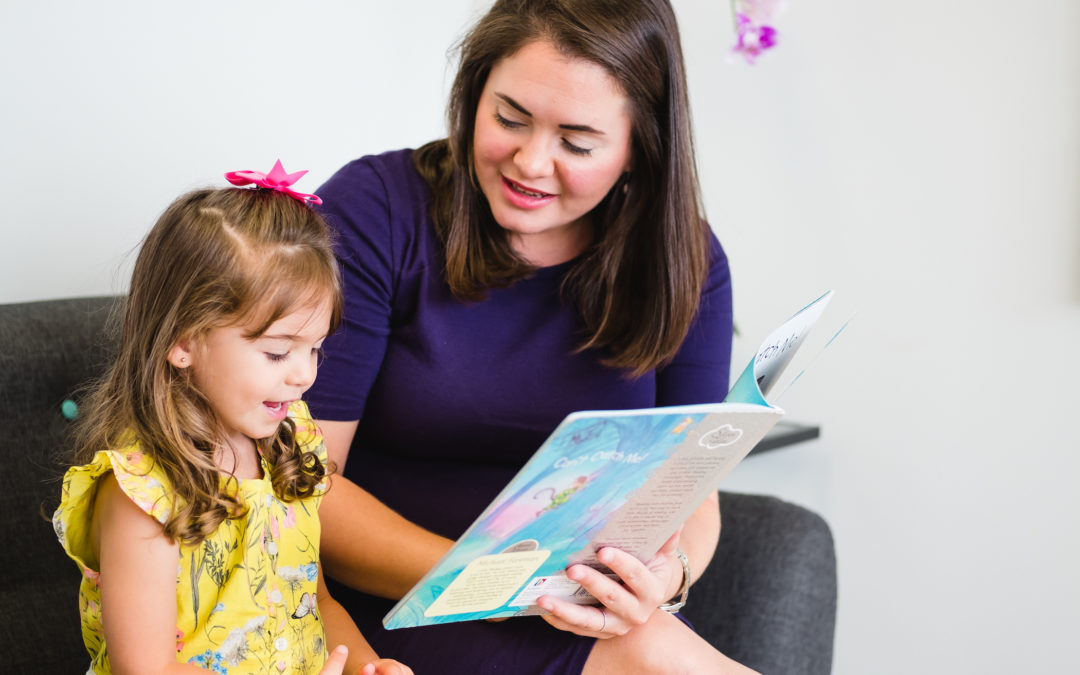Reading is an important language-learning tool for all children, but it can be especially powerful for those who struggle with communication. We checked in with one of our speech-language pathologists, Erica Lord, who runs our Tiny Talkers program, to get her tips on using reading to build language skills.
How Does Reading Support Language Development?
When we say reading you may envision an adult reading from a book while a child listens, but reading has the potential to be a highly-interactive activity! Allowing children to be the narrator, point, ask questions, and comment on what they see or hear are all opportunities to practice communication skills (initiating, using gestures, requesting information, expressing an idea, etc.).
What’s more, visuals are a valuable tool in teaching language skills, and children’s books are naturally visually-oriented. “They allow children to connect what they see to what they hear, which reinforces the learning,” Erica says.
Tips for Reading with Your Child
Choose Books with Simple, Repetitive Phrases
The rhythmic nature of these books helps keep your child engaged. The predictability helps him learn, practice and remember speech sounds, words, phrases and grammar. Because the stories are simple and repetitive, language and narrative concepts are easier for your child to grasp.
Here are some of Erica’s favorites, which she recommends from toddlerhood to early elementary school:
- Brown Bear, Brown Bear
- Have You Seen My Cat
- Blue Hat, Green Hat
- Up to Ten and Down Again
- Jump, Frog, Jump!
- Who’s Making That Mess?
Take Your Time
Reading at a slow pace gives your child time to process what he sees and hears. It also allows him to jump in and point something out or ask a question if he wants to.
Be an Actor
Read as if it’s your Broadway debut! Using inflection and even a sing-song voice not only keeps your child engaged, it also teaches him about expression of emotions and feelings, and how to use language in different ways depending on the context in which it’s being used.
Encourage Your Child to Read Along with You
Two great ways to do this, Erica says, are pausing and prompting. Once your child is familiar with a book, you can read just the beginning of a phrase and then pause, waiting for him to finish it. If he needs a nudge, you can prompt him: Let’s say this together. Encouraging his participation is an excellent way to reinforce speech sounds, vocabulary, grammar, and working memory.
Emphasize Pictures
Now that we’ve sung the praises of books with simple, repetitive words and phrases, we’re going to switch gears. Reading the words is great for all the reasons we’ve mentioned, but don’t be afraid to focus on just the pictures, too.
Talking about what you both see creates opportunities for shared attention and valuable back-and-forth interactions that nurture language development. Focusing on the pictures also helps him practice scanning the entire page and using visual discrimination to identify objects. You can use pictures to tell a different version of the story, too, which helps teach new descriptive vocabulary, expand on ideas, and build flexible thinking.
Avoid Quizzing
It can be tempting to view reading as a time to ask your child a lot of questions, like where is the ball, what color is this, or what does the cat say? Some questions are okay, Erica says, but it’s easy to overdo it. “Asking too many questions can provoke frustration, or even anxiety.” Instead, she says, use modeling: Here’s something I like in this picture. Then pause, giving your child a chance to point out something he likes, too.
Have Fun!
Above all, Erica says, remember that if you’re having fun, your child will, too.


Recent Comments